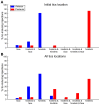Motor tics evoked by striatal disinhibition in the rat
- PMID: 24065893
- PMCID: PMC3776161
- DOI: 10.3389/fnsys.2013.00050
Motor tics evoked by striatal disinhibition in the rat
Abstract
Motor tics are sudden, brief, repetitive movements that constitute the main symptom of Tourette syndrome (TS). Multiple lines of evidence suggest the involvement of the cortico-basal ganglia system, and in particular the basal ganglia input structure-the striatum in tic formation. The striatum receives somatotopically organized cortical projections and contains an internal GABAergic network of interneurons and projection neurons' collaterals. Disruption of local striatal GABAergic connectivity has been associated with TS and was found to induce abnormal movements in model animals. We have previously described the behavioral and neurophysiological characteristics of motor tics induced in monkeys by local striatal microinjections of the GABAA antagonist bicuculline. In the current study we explored the abnormal movements induced by a similar manipulation in freely moving rats. We targeted microinjections to different parts of the dorsal striatum, and examined the effects of this manipulation on the induced tic properties, such as latency, duration, and somatic localization. Tics induced by striatal disinhibition in monkeys and rats shared multiple properties: tics began within several minutes after microinjection, were expressed solely in the contralateral side, and waxed and waned around a mean inter-tic interval of 1-4 s. A clear somatotopic organization was observed only in rats, where injections to the anterior or posterior striatum led to tics in the forelimb or hindlimb areas, respectively. These results suggest that striatal disinhibition in the rat may be used to model motor tics such as observed in TS. Establishing this reliable and accessible animal model could facilitate the study of the neural mechanisms underlying motor tics, and the testing of potential therapies for tic disorders.
Keywords: GABA; Tourette syndrome; basal ganglia; bicuculline; striatum.
Figures





Similar articles
-
The neurophysiological correlates of motor tics following focal striatal disinhibition.Brain. 2009 Aug;132(Pt 8):2125-38. doi: 10.1093/brain/awp142. Epub 2009 Jun 8. Brain. 2009. PMID: 19506070
-
Corticostriatal Divergent Function in Determining the Temporal and Spatial Properties of Motor Tics.J Neurosci. 2015 Dec 16;35(50):16340-51. doi: 10.1523/JNEUROSCI.2770-15.2015. J Neurosci. 2015. PMID: 26674861 Free PMC article.
-
Global dysrhythmia of cerebro-basal ganglia-cerebellar networks underlies motor tics following striatal disinhibition.J Neurosci. 2013 Jan 9;33(2):697-708. doi: 10.1523/JNEUROSCI.4018-12.2013. J Neurosci. 2013. PMID: 23303948 Free PMC article.
-
Tic disorders: what happens in the basal ganglia?Neuroscientist. 2013 Feb;19(1):101-8. doi: 10.1177/1073858412444466. Epub 2012 May 16. Neuroscientist. 2013. PMID: 22596263 Review.
-
Tics and Tourette's: update on pathophysiology and tic control.Curr Opin Neurol. 2016 Aug;29(4):513-8. doi: 10.1097/WCO.0000000000000356. Curr Opin Neurol. 2016. PMID: 27310537 Review.
Cited by
-
Abnormal neuronal activity in Tourette syndrome and its modulation using deep brain stimulation.J Neurophysiol. 2015 Jul;114(1):6-20. doi: 10.1152/jn.00277.2015. Epub 2015 Apr 29. J Neurophysiol. 2015. PMID: 25925326 Free PMC article. Review.
-
Clinical Features That Evoke the Concept of Disinhibition in Tourette Syndrome.Front Psychiatry. 2020 Feb 25;11:21. doi: 10.3389/fpsyt.2020.00021. eCollection 2020. Front Psychiatry. 2020. PMID: 32161555 Free PMC article. Review.
-
Aripiprazole Selectively Reduces Motor Tics in a Young Animal Model for Tourette's Syndrome and Comorbid Attention Deficit and Hyperactivity Disorder.Front Neurol. 2018 Feb 13;9:59. doi: 10.3389/fneur.2018.00059. eCollection 2018. Front Neurol. 2018. PMID: 29487562 Free PMC article.
-
Histamine and the striatum.Neuropharmacology. 2016 Jul;106:74-84. doi: 10.1016/j.neuropharm.2015.08.013. Epub 2015 Aug 11. Neuropharmacology. 2016. PMID: 26275849 Free PMC article. Review.
-
A spiking computational model for striatal cholinergic interneurons.Brain Struct Funct. 2023 Mar;228(2):589-611. doi: 10.1007/s00429-022-02604-9. Epub 2023 Jan 18. Brain Struct Funct. 2023. PMID: 36653544
References
-
- Alexander G. E., DeLong M. R. (1985). Microstimulation of the primate neostriatum. II. Somatotopic organization of striatal microexcitable zones and their relation to neuronal response properties. J. Neurophysiol. 53, 1417–1430 - PubMed
LinkOut - more resources
Full Text Sources
Other Literature Sources

